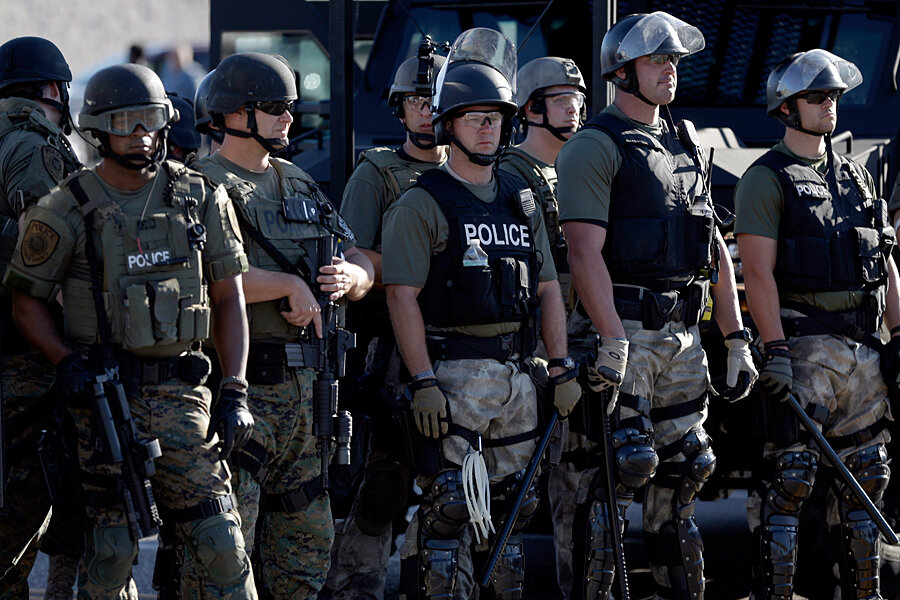Mike Brown shooting: Images of militarized police bring out critics
Loading...
A militarized response to a fourth night of protests may have fueled more unrest rather than quelling it in Ferguson, Mo., where a police officer on Saturday shot and killed an unarmed black teenager.
Images from Ferguson taken Wednesday night show some protesters using the hands-up-don’t-shoot gesture as local police, clad in camouflage uniforms with small “POLICE” badges, pushed people off the street with tear gas and rubber bullets.
As police assembled Wednesday, the St. Louis Post-Dispatch reported, they attached what the paper called "high-caliber automatic weapons" on top of armored vehicles and aimed them at the throngs of some 350 protesters.
After watching the police response, Gov. Jay Nixon (D) indicated he would take St. Louis County police out of the situation, according to Rep. William Lacy Clay (D) of Missouri. However, Ferguson police have also been part of the response.
Critics say that the scenes in recent days from Ferguson are offering Americans an unvarnished look at one consequence of federal programs that supply even tiny towns and small cities with heavy military equipment designed not for US streets, but for foreign battlefields.
Since the late 1990s, a Pentagon program known as “1033,” whose motto is “From Warfighter to Crimefighter,” has provided $4.3 billion worth of used and surplus equipment – including small tanks, night scopes, and high-powered rifles – to thousands of small towns and cities, including Ferguson, worried about terrorism.
While arguably well intended, the impulse to put the equipment into use in the absence of terror attacks, critics say, has helped to shift the nature of American policing, especially in minority communities, from a protect-and-serve mind-set to a soldier-at-war mentality.
Documenting a dramatic increase in the use of heavily armed SWAT teams for nonviolent crimes like gambling or pot dealing, a recent report by the American Civil Liberties Union argued that “American policing has become unnecessarily and dangerously militarized, in large part through federal programs that have armed state and local law enforcement agencies with the weapons and tactics of war, with almost no public discussion or oversight.”
The majority of SWAT team raids on nonviolent lawbreakers, the ACLU report points out, happen in black neighborhoods. But when the teams are used for hostage-and-rescue situations, the subjects are usually white, according to the report, which is based on Freedom of Information Act requests.
Ferguson (pop. 21,000) is a black suburb with a predominantly white police force.
To be sure, Ferguson Police Chief Thomas Jackson has said the law-and-order approach in recent days is warranted to protect police and the community from injury and damage. Still, Ferguson police officials said they will review their tactics following Wednesday night’s clashes.
President Obama interrupted his Martha’s Vineyard vacation to receive briefings from Attorney General Eric Holder about the escalating clashes.
“There is never an excuse for violence against police or for those who would use this tragedy as a cover for vandalism or looting,” Mr. Obama said Thursday in Edgartown, Mass. “There’s also no excuse for police to use excessive force against peaceful protests or to throw protesters in jail for lawfully exercising their First Amendment rights.”
There were conflicting reports about what started the police assault on protesters Wednesday night. “Bottles were being thrown ... and we had a police officer break an ankle from a thrown brick,” Brian Schellman, a spokesman for St. Louis County police, told the British newspaper the Guardian. Police “acted with great restraint,” he said.
The teenager shot on Saturday was Mike Brown, who witnesses said had his hands raised in surrender.
According to Drexel University policing expert Robert Kane, Ferguson is seeing “nothing short of an urban rebellion against the justice system” as police have not provided answers as to why the officer engaged with the teen and how the altercation turned deadly. Police have not released the officer’s name, citing safety concerns, and have not revealed details of an autopsy that would indicate the number of bullets the teen took.
The scenes this week of local police looking like soldiers and attacking protesters has begun to disturb US officials.
Rep. Justin Amash (R) of Michigan tweeted late Wednesday, “Images & reports out of #Ferguson are frightening. Is this a war zone or a US city? Gov’t escalates tensions w/military equipment and tactics.”
The decision to meet the protesters with a “heavy hand” has “made the situation worse,” added St. Louis Alderman Antonio French, who was arrested by police Wednesday after he didn’t move fast enough when ordered away. He was released Thursday morning.
And in a piece in Time magazine, Sen. Rand Paul (R) of Kentucky wrote: "There is a legitimate role for the police to keep the peace, but there should be a difference between a police response and a military response. The images and scenes we continue to see in Ferguson resemble war more than traditional police action."








